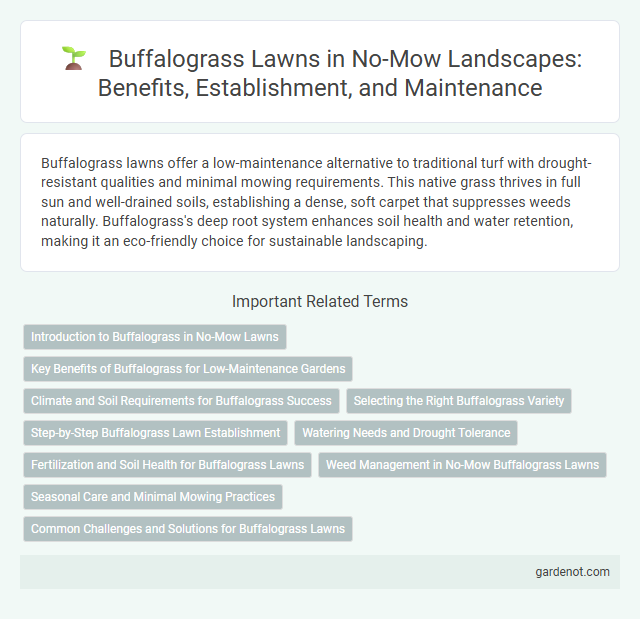Buffalograss lawns offer a low-maintenance alternative to traditional turf with drought-resistant qualities and minimal mowing requirements. This native grass thrives in full sun and well-drained soils, establishing a dense, soft carpet that suppresses weeds naturally. Buffalograss's deep root system enhances soil health and water retention, making it an eco-friendly choice for sustainable landscaping.
Introduction to Buffalograss in No-Mow Lawns
Buffalograss (Bouteloua dactyloides) is a native North American grass species ideal for no-mow lawns due to its low growth habit and drought tolerance. This warm-season grass requires minimal watering and mowing, thriving in full sun with excellent resistance to heat and pests. Its dense, carpet-like texture reduces the need for fertilization and upkeep, making Buffalograss a sustainable choice for eco-friendly, low-maintenance landscapes.
Key Benefits of Buffalograss for Low-Maintenance Gardens
Buffalograss requires minimal mowing, thriving in low-maintenance gardens with its natural drought resistance and deep root system that reduces water consumption. This warm-season grass is highly tolerant to heat, pests, and diseases, making it ideal for sustainable landscaping and reducing the need for fertilizers and pesticides. Its soft texture and dense growth also help prevent soil erosion while providing a lush, green aesthetic with less effort than traditional lawn grasses.
Climate and Soil Requirements for Buffalograss Success
Buffalograss thrives in warm climates with full sun exposure and is highly drought-tolerant, making it ideal for regions with hot summers and mild winters. It prefers well-drained, sandy to loamy soils with a pH range of 6.0 to 7.5, ensuring healthy root development and growth. Poorly drained or heavy clay soils can inhibit Buffalograss success, highlighting the need for proper soil preparation and drainage management.
Selecting the Right Buffalograss Variety
Selecting the right Buffalograss variety depends on regional climate, soil type, and desired maintenance levels, with popular options including 'Density' for drought tolerance and 'Bowie' for cold hardiness. Buffalograss varieties like 'Legacy' offer enhanced color and texture, making them suitable for ornamental lawns requiring low mowing frequency. Proper variety selection ensures optimal growth, minimal watering, and reduced mowing, supporting sustainable no-mow lawn practices.
Step-by-Step Buffalograss Lawn Establishment
Buffalograss lawn establishment begins with selecting high-quality seeds or plugs adapted to warm-season climates, ensuring drought tolerance and low maintenance requirements. Prepare the soil by removing weeds, loosening the topsoil to a depth of 4-6 inches, and amending with organic matter to enhance fertility and drainage. Plant seeds or plugs during late spring to early summer, maintain consistent moisture until establishment, and mow sparingly to strengthen root development for a thick, resilient no-mow lawn.
Watering Needs and Drought Tolerance
Buffalograss lawns require minimal watering compared to traditional turfgrass, adapting well to low-moisture conditions with only 1 to 1.5 inches of water per week during peak growing seasons. This warm-season grass exhibits high drought tolerance due to its deep root system, allowing it to survive extended dry periods without supplemental irrigation. Its resilience makes Buffalograss an ideal choice for no-mow, water-efficient landscapes in arid and semi-arid regions.
Fertilization and Soil Health for Buffalograss Lawns
Buffalograss lawns thrive in well-drained soils with moderate fertility, requiring minimal fertilization compared to traditional cool-season grasses. Applying a slow-release, low-nitrogen fertilizer once in early spring promotes healthy growth while maintaining soil microbial balance and preventing nutrient runoff. Enhancing soil health through organic matter incorporation and regular aeration supports buffalograss root development and drought resilience.
Weed Management in No-Mow Buffalograss Lawns
Buffalograss lawns naturally resist many common weeds due to their dense growth habit and low maintenance requirements, making them ideal for no-mow landscapes. Effective weed management in no-mow Buffalograss lawns relies on maintaining proper soil health and ensuring adequate irrigation to reduce weed seed germination. Selective herbicides compatible with Buffalograss can be applied during active growth phases to control persistent weeds without damaging the native turfgrass.
Seasonal Care and Minimal Mowing Practices
Buffalograss lawns require minimal mowing, typically once every two to three weeks during the active growing season, thanks to their slow growth rate. Seasonal care involves light watering in early spring and late fall to sustain drought tolerance, along with occasional dethatching to promote healthy growth. Fertilization is best limited to early spring with a low-nitrogen formula to enhance turf density without encouraging excessive growth.
Common Challenges and Solutions for Buffalograss Lawns
Buffalograss lawns often face challenges such as drought stress, patchy growth, and susceptibility to weeds due to their slow establishment and shallow root system. Regular deep watering during dry spells and aeration can improve drought resilience and promote healthy root development. Implementing a consistent weed control regimen with selective herbicides and proper mowing height helps maintain a dense, vigorous Buffalograss turf that requires minimal mowing.
Buffalograss lawn Infographic

 gardenot.com
gardenot.com